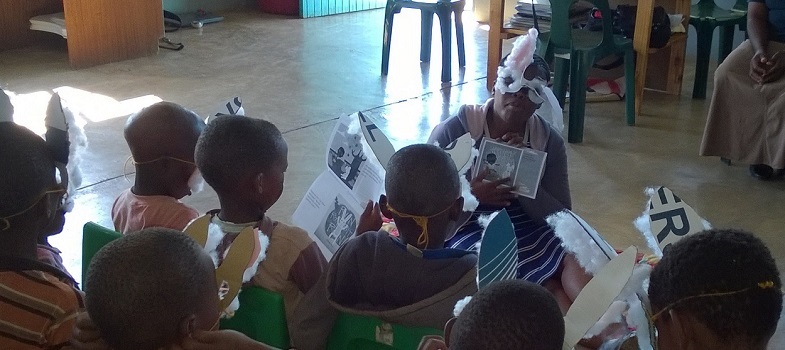Using storybooks to develop speaking and listening skills
Storybooks can be used in many ways to support children's early reading. Children listening to their teacher read aloud a story supports listening comprehension, which is a crucial skill for developing children’s text comprehension. Having listened to the teacher read aloud the story, children can be encouraged to retell the story. Retelling stories is valuable because:
- children have to listen carefully
- children need to use their memory
- it helps to develop children’s vocabulary – they need to find and use words to say what they remember.
Most importantly of all, it is by listening to and retelling stories that children learn the ‘narrative structures’ that will help them to make sense of the world around them.
But what kind of stories are good for retelling? Ideally, they should:
- be in the children’s home language, or a language that they understand and can speak well
- be enjoyable
- be easy to remember
- have a recurring sequence
- have patterns like rhyme, rhythm and repetition
- contain memorable events and characters.
If the stories are in a book, then it is also helpful to have clear, interesting pictures.
In Activity 5.2 you will think about a storybook that is good to use for children to retell the story. It will be good if you can make time to do the activity with a small group of children. In the activity you will use one of the three stories you have found from the ASb website.
Activity 5.2: Retelling stories
- Choose one of the three stories that you either downloaded or wrote down titles from and read it.
- If you are with a group of other teachers or colleagues, talk about three important reasons why you think this is a good story for a retelling activity with children, using the criteria above.
- Write down the reasons in your study notebook.
- If it is not a good story for retelling, say why and choose another one.
- Retell the story yourself without reading it and using your own words. Then reflect on this: was it hard or easy, and what did you gain from the experience yourself?
- Now read the description below of retelling stories and do the activity with a group of children or with your colleagues pretending to be children.
- a.Call a child or a small group of children aside.
- b.Read the story in the way you would usually tell a story. That is:
- Show the children the picture on the cover.
- Read the title and talk about what it tells us about the story.
- Ask children predictive questions, such as ‘What do you think the story is about?’, or ‘Who do you think is the main character of the story?’
- Introduce any new words before you read. Ask the children if they know the meaning of new words, so that they can learn from each other too.
- Read the story.
- c.After you’ve read the story, ask the children some simple, closed questions about it.
- d.Ask the children to make up some questions for each other about the story.
- e.Retell the story yourself, and ask the children to help you with some simple prompts: ‘Why did she do that …?’, or ‘What happened when …?’
- f.Ask if anyone would like to retell the story.
- When you have finished reading and retelling the story, write a reflection in your study notebook using the following questions to guide you:
- a.How well did the children retell the story? What was easy for them, and what was not so easy?
- b.What will you change or improve next time?
- c.Could children do this activity independently? Are there any props that they could use? Could they do it in pairs or small groups?
Introduction



